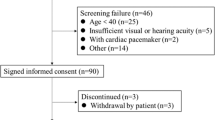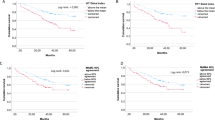Abstract
Background/objectives
Sarcopenia is associated with increased mortality. European and North American recommended screening for low muscle mass uses gender specific cut points, with no adjustment for ethnicity. We wished to determine whether the prevalence of sarcopenia was altered by ethnicity in peritoneal dialysis (PD) patients.
Subjects/methods
We measured appendicular lean mass indexed to height (ALMI) in PD patients by segmental bioimpedance and determined sarcopenia using different cut off points for reduced muscle mass.
Results
We measured ALMI in 434 PD patients, 55.1% males, mean age 55.3 ± 16.2 years, 32.3% diabetic, 54.1% white, 23.7% Asian, 19.1% black. ALMI was lower in Asian women, compared to white and black women (6.4 ± 1.1 vs. 6.6 ± 1.0 and 6.9 ± 1.4 kg/m2), and lower in Asian men (7.5 ± 1.3 vs. 8.5 ± 1.2 and 8.7 ± 1.3 kg/m2), p < 0.001. Depending on the ALM/ALMI cut point; the prevalence of sarcopenia was greater in Asian patients (25.6–41.2% using North American or European cut points) compared to white (12.3–18.7%) and black patients (3.8–15.7%), p < 0.001, but <11% when using Asian-specific cut points. The prevalence of sarcopenia obesity (BMI ≥ 30 kg/m2) was <3%, for all groups. There was no association with duration of PD, dialysis prescription, residual renal function or small solute clearances.
Conclusions
There is no universally agreed consensus definition for loss of muscle mass (sarcopenia) and current European and North American recommended cut points for screening are adjusted only for gender. As body composition differs also with age and ethnicity, then ideally cut points should be based on age, gender and ethnicity normative values.
This is a preview of subscription content, access via your institution
Access options
Subscribe to this journal
Receive 12 print issues and online access
$259.00 per year
only $21.58 per issue
Buy this article
- Purchase on Springer Link
- Instant access to full article PDF
Prices may be subject to local taxes which are calculated during checkout



Similar content being viewed by others
References
Dhillon RJ, Hasni S. Pathogenesis and management of sarcopenia. Clin Geriatr Med. 2017;33:17–26.
Hirai K, Ookawara S, Morishita Y. Sarcopenia and physical inactivity in patients with chronic kidney disease. Nephrourol Mon. 2016;8:e37443.
Cruz-Jentoft AJ, Baeyens JP, Bauer JM, Boirie Y, Cederholm T, Landi F, et al European Working Group on sarcopenia in older people. sarcopenia: European consensus on definition and diagnosis: report of the European Working Group on sarcopenia in older people. Age Ageing. 2010;39:412–23.
Cawthon PM, Peters KW, Shardell MD, McLean RR, Dam TT, Kenny AM, et al. Cutpoints for low appendicular lean mass that identify older adults with clinically significant weakness. J Gerontol A Biol Sci Med Sci. 2014;69:567–75.
Baumgartner RN, Koehler KM, Gallagher D, Romero L, Heymsfield SB, Ross RR, et al. Epidemiology of sarcopenia among the elderly in New Mexico. Am J Epidemiol. 1998;147:755–63.
Kyle UG, Schutz Y, Dupertuis YM, Pichard C. Body composition interpretation. Contributions of the fat-free mass index and the body fat mass index. Nutrition. 2003;19:597–604.
Kelly TL, Wilson KE, Heymsfield SB. Dual energy X-ray absorptiometry body composition reference values from NHANES. PLoS ONE. 2009;4:e7038.
Fürstenberg A, Davenport A. Comparison of multifrequency bioelectrical impedance analysis and dual-energy X-ray absorptiometry assessments in outpatient haemodialysis patients. Am J Kidney Dis. 2010;57:123–29.
Fürstenberg A, Davenport A. Assessment of body composition in peritoneal dialysis patients using bioelectrical impedance and dual-energy x-ray absorptiometry. Am J Nephrol. 2011;33:150–6.
Davenport A. Does peritoneal dialysate affect body composition assessments using multi-frequency bioimpedance in peritoneal dialysis patients? Eur J Clin Nutr. 2013;67:223–5.
Davenport A, Willicombe M. Comparison of fluid status in patients treated by different modalities of peritoneal dialysis using multi-frequency bioimpedance. Int J Artif Organs. 2009;32:779–86.
Chen LK, Liu LK, Woo J, Assantachai P, Auyeung TW, Bahyah KS, et al. Sarcopenia in Asia: consensus report of the Asian Working Group for Sarcopenia. J Am Med Dir Assoc. 2014;15:95–101.
WHO Expert Consultation. Appropriate body-mass index for Asian populations and its implications for policy and intervention strategies. Lancet. 2004;363:157–63.
Stenholm S, Harris TB, Rantanen T, Visser M, Kritchevsky SB, Ferrucci L. Sarcopenic obesity—definition, aetiology and consequences. Curr Opin Clin Nutr Metab Care. 2008;11:693–700.
Peritoneal Dialysis Adequacy Work Group. Clinical practice recommendations for peritoneal dialysis adequacy. Am J Kid Dis. 2006;48:S98–158.
Rajakaruna G, Caplin B, Davenport A. Peritoneal protein clearance rather than faster transport status determines outcomes in peritoneal dialysis patients. Perit Dial Int. 2015;35:216–21.
Bergstrom J, Furst P, Alvestrand A, Lindholm B. Protein and energy intake, nitrogen balance and nitrogen losses in patients treated with continuous ambulatory peritoneal dialysis. Kidney Int. 1993;44:1048–57.
Davies SJ, Phillips L, Naish PF, Russell GI. Quantifying comorbidity in peritoneal dialysis patients and its relationship to other predictors of survival. Nephrol Dial Transplant. 2002;17:1085–92.
Carrero JJ, Chmielewski M, Axelsson J, Snaedal S, Heimbürger O, Bárány P, et al. Muscle atrophy, inflammation and clinical outcome in incident and prevalent dialysis patients. Clin Nutr. 2008;27:557–64.
Lamarca F, Carrero JJ, Rodrigues JC, Bigogno FG, Fetter RL, Avesani CM. Prevalence of sarcopenia in elderly maintenance hemodialysis patients: the impact of different diagnostic criteria. J Nutr Health Aging. 2014;18:710–7.
Sawant A, House AA, Chesworth BM, Connelly DM, Lindsay R, Gati J, et al. Association between muscle hydration measures acquired using bioelectrical impedance spectroscopy and magnetic resonance imaging in healthy and haemodialysis population. Physiol Rep. 2015;3:e12219.
Panorchan K, Nongnuch A, El-Kateb S, Goodlad C, Davenport A. Changes in muscle and fat mass with haemodialysis detected by multi-frequency bioelectrical impedance analysis. Eur J Clin Nutr. 2015;69:1109–12.
Kang SH, Cho KH, Park JW, Yoon KW, Do JY. Comparison of bioimpedance analysis and dual-energy X-ray absorptiometry body composition measurements in peritoneal dialysis patients according to oedema. Clin Nephrol. 2013;79:261–8.
Davenport A, Argawal B, Wright G, Mantzoukis K, Dimitrova R, Davar J, et al. Can non-invasive measurements aid clinical assessment of volume in patients with cirrhosis? World J Hepatol. 2013;5:433–8.
Davenport A. Effect of intra-abdominal dialysate on bioimpedance-derived fluid volume status and body composition measurements in peritoneal dialysis patients. Perit Dial Int. 2013;33:578–9.
Rincón Bello A, Bucalo L, Abad Estébanez S, Vega Martínez A, Barraca Núñez D, Yuste Lozano C, et al. Fat tissue and inflammation in patients undergoing peritoneal dialysis. Clin Kidney J. 2016;9:374–80.
Ikizler TA, Cano NJ, Franch H, Fouque D, Himmelfarb J, Kalantar-Zadeh K, et al. International society of renal nutrition and metabolism. prevention and treatment of protein energy wasting in chronic kidney disease patients: a consensus statement by the international society of renal nutrition and metabolism. Kidney Int. 2013;84:1096–107.
Batsis JA, Barre LK, Mackenzie TA, Pratt SI, Lopez-Jimenez F, Bartels SJ. Variation in the prevalence of sarcopenia and sarcopenic obesity in older adults associated with different research definitions: dual-energy X-ray absorptiometry data from the National Health and Nutrition Examination Survey 1999-2004. J Am Geriatr Soc. 2013;61:974–80.
Malhotra R, Deger SM, Salat H, Bian A, Stewart TG, Booker C, et al. Sarcopenic obesity definitions by body composition and mortality in the haemodialysis patients. J Ren Nutr. 2016;27:84–90.
Sridharan S, Vilar E, Davenport A, Ashman N, Almond M, Banerjee A, et al. Scaling hemodialysis target dose to reflect body surface area, metabolic activity, and protein catabolic rate: a prospective, cross-sectional study. Am J Kidney Dis. 2016;69:358–66.
El-Kateb S, Sridharan S, Farrington K, Fan S, Davenport A. A single weekly Kt/Vurea target for peritoneal dialysis patients does not provide an equal dialysis dose for all. Kidney Int. 2016;90:1342–47.
Moon JH, Kim KM, Kim JH, Moon JH, Choi SH, Lim S, et al. Predictive values of the new sarcopenia index by the foundation for the National Institutes of Health Sarcopenia Project for mortality among older Korean adults. PLoS One. 2016;11:e0166344.
Yamada Y, Nishizawa M, Uchiyama T, Kasahara Y, Shindo M, Miyachi M, et al. Developing and validating an age-independent equation using multi-frequency bioelectrical impedance analysis for estimation of appendicular skeletal muscle mass and establishing a cutoff for sarcopenia. Int J Environ Res Public Health. 2017;14:pii:E809; https://doi.org/10.3390/ijerph14070809.
Wang H, Hai S, Cao L, Zhou J, Liu P, Dong BR. Estimation of prevalence of sarcopenia by using a new bioelectrical impedance analysis in Chinese community-dwelling elderly people. BMC Geriatr. 2016;16:216; https://doi.org/10.1186/s12877-016-0386-z.
Ishii S, Tanaka T, Shibasaki K, Ouchi Y, Kikutani T, Higashiguchi T, et al. Development of a simple screening test for sarcopenia in older adults. Geriatr Gerontol Int. 2014;14:93–101.
Davenport A, Hussain Sayed R, Fan S. The effect of racial origin on total body water volume in peritoneal dialysis patients. Clin J Am Soc Nephrol. 2011;6:2492–8.
Friedli K, Guirguis A, Almond M, Day C, Chilcot J, Da Silva-Gane M, et al. Sertraline versus placebo in patients with major depressive disorder undergoing hemodialysis: a randomized, controlled feasibility trial. Clin J Am Soc Nephrol. 2017;12:280–86.
Author information
Authors and Affiliations
Corresponding authors
Ethics declarations
Conflict of interest
The authors have no competing interests.
Additional information
Publisher's note: Springer Nature remains neutral with regard to jurisdictional claims in published maps and institutional affiliations.
Rights and permissions
About this article
Cite this article
Yoowannakul, S., Tangvoraphonkchai, K. & Davenport, A. The prevalence of muscle wasting (sarcopenia) in peritoneal dialysis patients varies with ethnicity due to differences in muscle mass measured by bioimpedance. Eur J Clin Nutr 72, 381–387 (2018). https://doi.org/10.1038/s41430-017-0033-6
Received:
Revised:
Accepted:
Published:
Issue Date:
DOI: https://doi.org/10.1038/s41430-017-0033-6
This article is cited by
-
Frailty, appendicular lean mass, osteoporosis and osteosarcopenia in peritoneal dialysis patients
Journal of Nephrology (2022)
-
Sarcopenia as a predictor of mortality among the critically ill in an intensive care unit: a systematic review and meta-analysis
BMC Geriatrics (2021)
-
Change in appendicular lean mass in patients established on peritoneal dialysis as measured by dual x-ray absorptiometry (DXA) scanning
European Journal of Clinical Nutrition (2021)
-
Toward the recognition and management of sarcopenia in routine clinical care
Nature Aging (2021)
-
The cut-off values of handgrip strength and lean mass index for sarcopenia among patients on peritoneal dialysis
Nutrition & Metabolism (2020)



